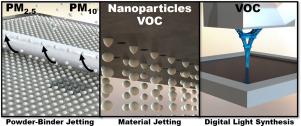Building and Environment ( IF 7.1 ) Pub Date : 2021-06-07 , DOI: 10.1016/j.buildenv.2021.108008 Austin C. Hayes , Jorge Osio-Norgaard , Shelly Miller , Gregory L. Whiting , Marina Vance

|
As additive manufacturing becomes more prevalent in industrial manufacturing facilities, so does human interaction with these machines. In this study, we characterized the size-resolved concentrations of particulate matter (PM, from 11 to 20,000 nm in size) and volatile organic compounds (VOC) resulting from a material-jetting (Projet 5500X), multi jet fusion (HP MJF 4200), and photopolymerization (Carbon 3D continuous liquid interface production). During all processes, PM concentrations were below the OSHA limits and ultrafine PM () concentrations were well below levels commonly observed for fused deposition modeling printers. PM and total volatile organic compound (VOC) concentrations during printing were close to background levels for the HP MJF printer and HP MJF post processing station. However, the mean particle size of the powder used (PA 12) was above the upper detection limit of the instrument (20 ). Carbon 3D total VOC levels were highest during part post processing. Cyclic PM emissions from the Projet 5500X printer suggested higher PM emissions during cooling fan activity. VOC analysis revealed high concentrations of HP ink solvents (2-Pyrrolidinone and Triethylene glycol), potential exposure to fluorinated compounds and photoresin VOCs during Carbon 3D post-processing, and exposure to photo-resin compounds during Projet 5500X printing. This study indicates that proper exhaust and facility air exchange can limit concentrations of PM and VOCs and therefore particular attention to the building design and ventilation system should be taken into consideration for additive manufacturing facilities to mitigate potential human exposure and associated health risks.
中文翻译:

服务局中多喷射融合、材料喷射和数字光合成商用 3D 打印机的空气污染物排放
随着增材制造在工业制造设施中变得越来越普遍,人类与这些机器的互动也越来越普遍。在这项研究中,我们表征了颗粒物(PM,来自11 到 20,000 nm 的尺寸)和挥发性有机化合物 (VOC) 产生的材料喷射(Projet 5500X)、多喷射融合(HP MJF 4200)和光聚合(碳 3D 连续液体界面生产)。在所有过程中,PM 浓度均低于 OSHA 限值和超细 PM() 浓度远低于熔融沉积建模打印机通常观察到的水平。打印过程中的 PM 和总挥发性有机化合物 (VOC) 浓度接近 HP MJF 打印机和 HP MJF 后处理站的背景水平。然而,所用粉末的平均粒径 (PA 12) 高于仪器的检测上限 (20)。在零件后处理期间,碳 3D 总 VOC 水平最高。Projet 5500X 打印机的循环 PM 排放表明冷却风扇活动期间 PM 排放量更高。VOC 分析揭示了高浓度的 HP 墨水溶剂(2-吡咯烷酮和三甘醇),在 Carbon 3D 后处理过程中可能暴露于氟化化合物和光树脂 VOC,以及在 Projet 5500X 打印过程中暴露于光树脂化合物。该研究表明,适当的排气和设施空气交换可以限制 PM 和 VOC 的浓度,因此增材制造设施应特别注意建筑设计和通风系统,以减轻潜在的人类暴露和相关的健康风险。











































 京公网安备 11010802027423号
京公网安备 11010802027423号